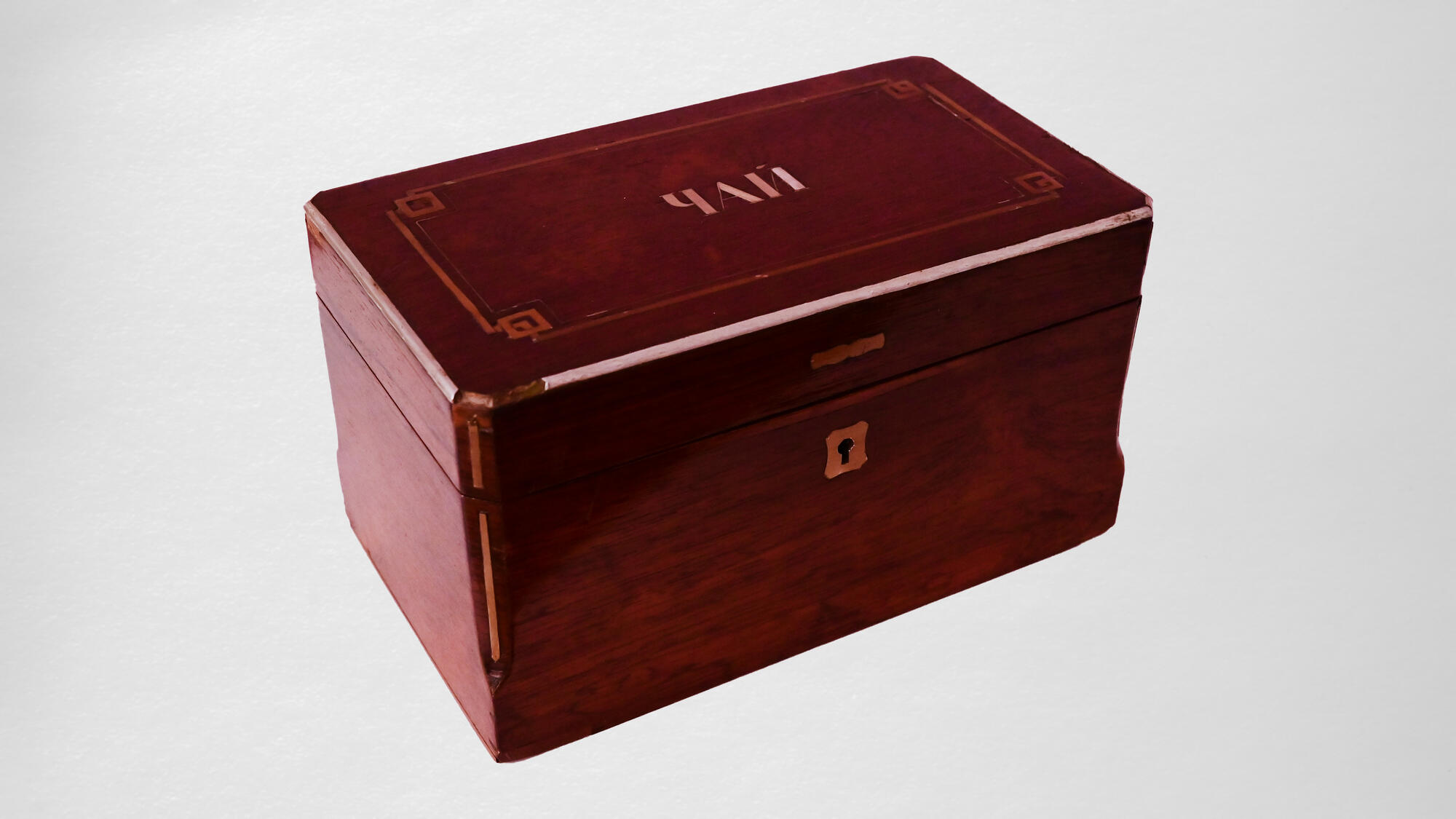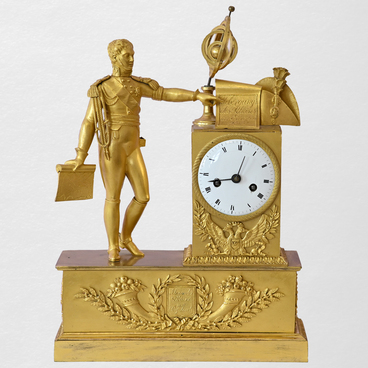The tea box with a hinged lid and cut corners, presented in the exhibition, belonged to the Tchaikovsky family. It is mounted on movable hinges. The lid is inlaid with a narrow metal strip with the inscription ‘Tea’ in the center. The lid trim is also inlaid with metal along the perimeter. The trim has two strips — one strip is dark yellow, and the second one is thin and looks like a thread. A locking mechanism with a metal overlay is embedded into the front panel of the case.
Tea appeared in Russia in the 17th century. Russian ambassador, boyar Vasily Starkov, brought gifts from the Khalkha Mongol leader Altyn Khan to Tsar Michael of Russia in 1638. Among the famous Mongolian atlases and furs, he brought bundles with dry leaves and instructions on brewing. Starkov at first refused to take sundried herbs, but the Mongol ruler insisted. Thus, tea appeared in Muscovy for the first time. Michael of Russia liked the drink, and the four poods (about 65 kilograms) of tea sent by Altyn Khan quickly ran out. Almost 30 years later, under Tsar Alexis of Russia, the ambassador to China Ivan Perfiliev brought tea to Russia again, and in 1769 Russia signed the first contract with China on supply of the goods.
The nobles could afford the best sorts of Chinese tea, expensive and rare, or flavored tea imported from Europe. The merchants preferred inexpensive, but dark tea. They drunk it in large quantities and made it weaker than the one the nobles preferred. The commoners had the cheapest and lowest-grade tea, using the leaves several times over. The ‘brewed again’ tea was called ‘Feldwebel tea’.
Pyotr Tchaikovsky’s mother, Alexandra d’Assier, went to the Nizhny Novgorod fair to buy tea when the family lived in Votkinsk. Tea was sold in ‘tsybiks’ — large packages that were divided into portions and stored in special ‘tea’ boxes, locked with a key. In the 19th century, tea was a very expensive product, and this way of storing was popular among assiduous housewives.
Tchaikovsky’s family did not keep the tea box in the dining room, but in Alexandra Assier’s bedroom instead. Expensive Chinese tea brought from the fair was given to the most important guests; it was brewed only on special occasions. Herbal tea was the everyday drink, for example, with oregano, mint, St. John’s wort, or tilia flowers.
Tea appeared in Russia in the 17th century. Russian ambassador, boyar Vasily Starkov, brought gifts from the Khalkha Mongol leader Altyn Khan to Tsar Michael of Russia in 1638. Among the famous Mongolian atlases and furs, he brought bundles with dry leaves and instructions on brewing. Starkov at first refused to take sundried herbs, but the Mongol ruler insisted. Thus, tea appeared in Muscovy for the first time. Michael of Russia liked the drink, and the four poods (about 65 kilograms) of tea sent by Altyn Khan quickly ran out. Almost 30 years later, under Tsar Alexis of Russia, the ambassador to China Ivan Perfiliev brought tea to Russia again, and in 1769 Russia signed the first contract with China on supply of the goods.
The nobles could afford the best sorts of Chinese tea, expensive and rare, or flavored tea imported from Europe. The merchants preferred inexpensive, but dark tea. They drunk it in large quantities and made it weaker than the one the nobles preferred. The commoners had the cheapest and lowest-grade tea, using the leaves several times over. The ‘brewed again’ tea was called ‘Feldwebel tea’.
Pyotr Tchaikovsky’s mother, Alexandra d’Assier, went to the Nizhny Novgorod fair to buy tea when the family lived in Votkinsk. Tea was sold in ‘tsybiks’ — large packages that were divided into portions and stored in special ‘tea’ boxes, locked with a key. In the 19th century, tea was a very expensive product, and this way of storing was popular among assiduous housewives.
Tchaikovsky’s family did not keep the tea box in the dining room, but in Alexandra Assier’s bedroom instead. Expensive Chinese tea brought from the fair was given to the most important guests; it was brewed only on special occasions. Herbal tea was the everyday drink, for example, with oregano, mint, St. John’s wort, or tilia flowers.



